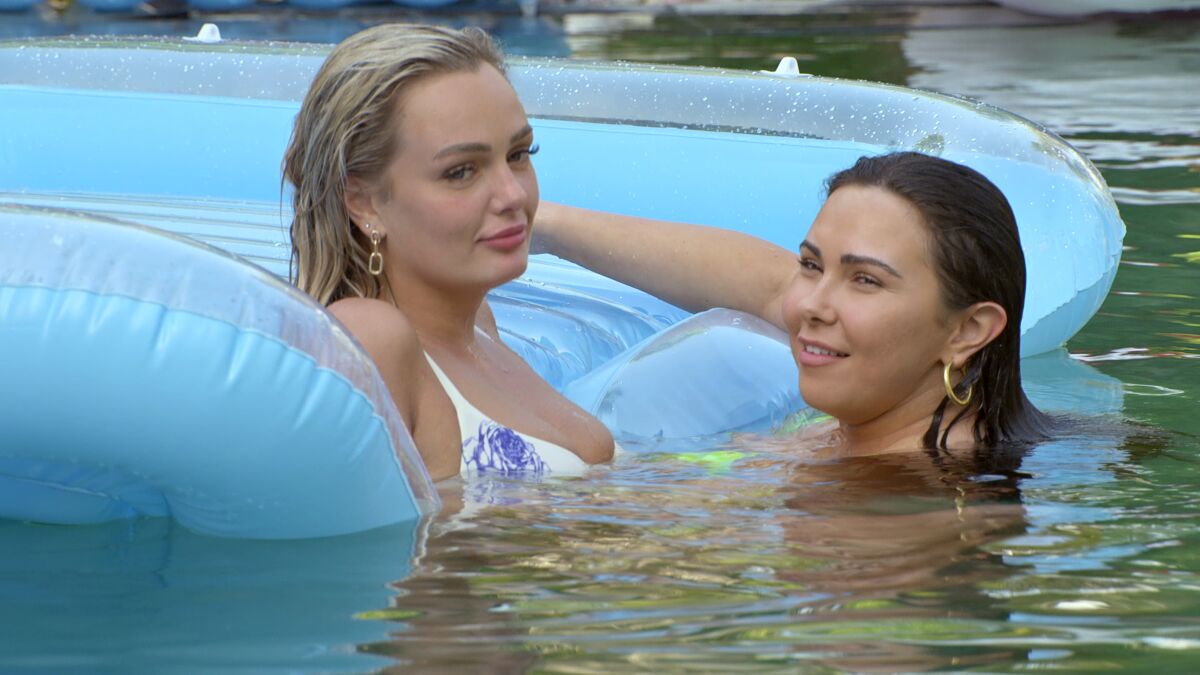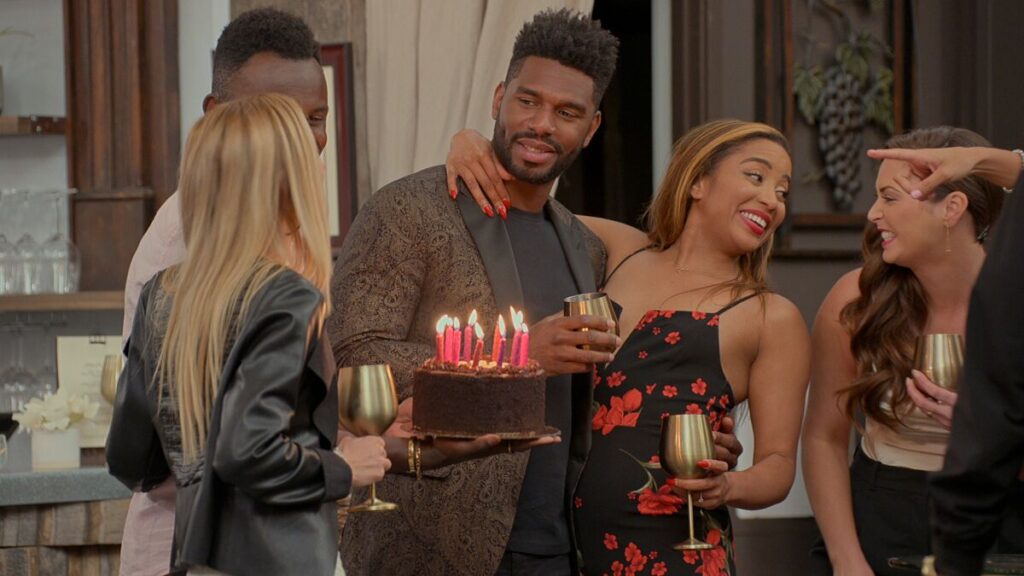Viewers have come to expect certain aesthetic flourishes from “Love is Blind,” Netflix’s smash hit reality show — er, “experiment” — following couples who get engaged before ever seeing each other.
There are the notorious gold wine glasses. The windowless pods that look like prison cells tricked out by Pier 1 Imports. The high-stakes but low-budget wedding ceremonies.
And through it all, there is the wall-to-wall soundtrack of infectious yet strangely disposable pop songs about love and heartache, with lyrics that narrate the show so perfectly they feel as if they were generated by artificial intelligence.
Consider a recent scene from the fourth — and arguably most unhinged — season, which concludes Friday. While enjoying a romantic date aboard a boat, lawyer Zack got down on one knee and proposed to project manager Bliss, who accepted even though she’d been passed over weeks earlier for another woman.
As Zack leaned in for a passionate kiss and ran his fingers through Bliss’ hair, a soulful acoustic song swelled on the soundtrack. “Kiss her with passion, as much as you can / Run your hands through her hair, whenever she’s sad,” went the lyrics, from “If You Love Her” by Forest Blakk, a Canadian recording artist whose earnest mid-tempo love songs turn up on “Love is Blind” nearly as often as hosts Nick and Vanessa Lachey.
This style of music has become pervasive on reality TV, especially glossy Netflix shows like “Love is Blind,” “Selling Sunset” and “Perfect Match,” emphasizing story beats, smoothing transitions and spelling out what cast members may be feeling — or at least what we’re supposed to think they’re feeling — at any given moment. And because most of the songs are not by well-known artists, many viewers are tapping on their Shazam app to find out where the music all comes from.
Chelsea, from left, Brett, Tiffany and Amber in “Love Is Blind.”
(Netflix)
“Everyone can remember hearing a song and whatever emotion they’re feeling at that point — whether it’s a huge high or they’re down in the doldrums — music can speak to that,” said series creator and showrunner Chris Coelen. “That’s what we want to try to capture with ‘Love is Blind’ — to have the music speak to and support the feelings that the people in the show are experiencing.”
Coelen said he was deeply involved in choosing the music cues for the first season, which helped establish a template for the show — the kinds of songs they would use, when and for how long. Now, he leans on collaborators including executive producer Ally Simpson and music supervisor Jon Ernst to help tell a story with music.
“We’ve been accused of creating our music for the show, which we do not do,” said Ernst.
Instead, he relies heavily on a category called “sync music” — music that is written with the specific goal of being used in movies, TV shows or commercials. “Artists and songwriters focus a lot of their talents on that because it’s a great stream of revenue for artists these days,” he said.
Many of the songs in the sync world deal with themes — love, heartbreak, joy — that are particularly relevant to “Love Is Blind.” But again, they aren’t songs just for “Love Is Blind.”
“People say, ‘Well, the lyric is so close to what they’re saying on camera,’” said Ernst. “It’s because we all feel the same emotions, especially when it comes to love, so it’s not that outlandish to think that a lyric might actually say almost the same thing that one of our cast members said onscreen.”
Ernst got his start as the DJ on the MTV dating show “Singled Out” in the mid-’90s, then moved into composing for reality TV, including “Laguna Beach: The Real Orange County.” It was on that massively influential MTV reality show — which put an unscripted spin on teen dramas like “The OC” — where he realized that “songs could be more important than score,” particularly when it came to illuminating the emotional lives of the characters.
Typically in reality TV, a lyrical song will be used when “a character isn’t saying quite the emotion, or the words that we needed them to say to convey what was going on onscreen,” he explained.
But there are debates about just how on-the-nose to get with the lyrics, said Coelen: “I don’t think we’re trying to have scenes where somebody’s walking out the door and the lyric’s like, ‘Walk on out the door.’”
The show’s popularity — each new season lands at or near the top of Netflix’s weekly rankings — means that it’s become attractive to artists. “We’ve had major labels come at us now that the show is such a huge juggernaut. They’re like, ‘Hey, how do we get on the show?’” said Ernst, who compiles music at the beginning of each season, looking for songs that fall into certain categories. There are love songs, breakup songs, high-energy “scene starters” that might be used to accompany a sweeping drone shot at the top of a scene. He turns this trove over to story producers and editors, who sift through it for nuggets of gold. “I’m the gatekeeper,” Ernst said. “But I’m not the decision-maker.”
Forest Blakk, whose songs have been used four times, was pitched to the show by the label and has become “the patron saint of ‘Love is Blind,’” Ernst joked. Other favorite artists include Fjøra, Summer Kennedy and Tyrone Wells.
Ernst likes songs that build from a low instrumental intro into a “massive emotional chorus. It just works magically.”

Micah and Irina in “Love Is Blind.”
(Netflix)
Other signatures include “gang vocals” that sound like they were sung by a large group of people and the so-called “millennial whoop” — a melodic pattern with repeated “whoa-oh-oh-whoa” sounds that “just bring a big giant feeling to the songs,” said Ernst. (He also worked on the first season of “Selling Sunset,” about a high-end L.A. real estate agency. That series also uses sync music, but in the service of a sound “more about women in power in high heels and ‘It’s going to be a great day’ kind of stuff,” he said.)
Because of budgetary limitations, “Love Is Blind” can’t use wall-to-wall hits, but well-known songs by Katy Perry, Coldplay and A Great Big World have appeared at pivotal moments throughout the series.
Meanwhile, the hit ballad “I Hope You Dance,” originally recorded by Lee Ann Womack, actually became part of the drama this season. Sparks first began to fly between Zack and Bliss — the couple whose roller-coaster romance provided one of the season’s more dramatic storylines — when they bonded over their shared love of the song, a fixture at weddings and graduations since its release in 2000. (Though Zack hilariously referred to Womack as “Lee Ann Wombat.”)
“The two of them just connected in so many ways on so many small things that took them by surprise, and this was one of them,” Coelen said. “This song had such big meaning to each of them.”
A soundalike cover of the song appears in the Season 4 finale during a montage of the final couples. Producers needed to isolate the instrumental track to play under dialogue — having lyrics over dialogue is too confusing — and had to use a cover because the master recording of Womack’s version was destroyed in a catastrophic fire at Universal Studios Hollywood in 2008.
“The lyrics are brilliant for this moment in the show,” Coelen said. “When you get the chance to sit it out or dance, it’s like, step up and grab your moment, life is short. That’s what the song is about. And certainly, the people in our show have all taken a big chance to try to find lifelong love.”
‘Love Is Blind’
Where: Netflix
When: Any time
Rating: TV-MA (may be unsuitable for children under the age of 17 with an advisory for coarse language)

